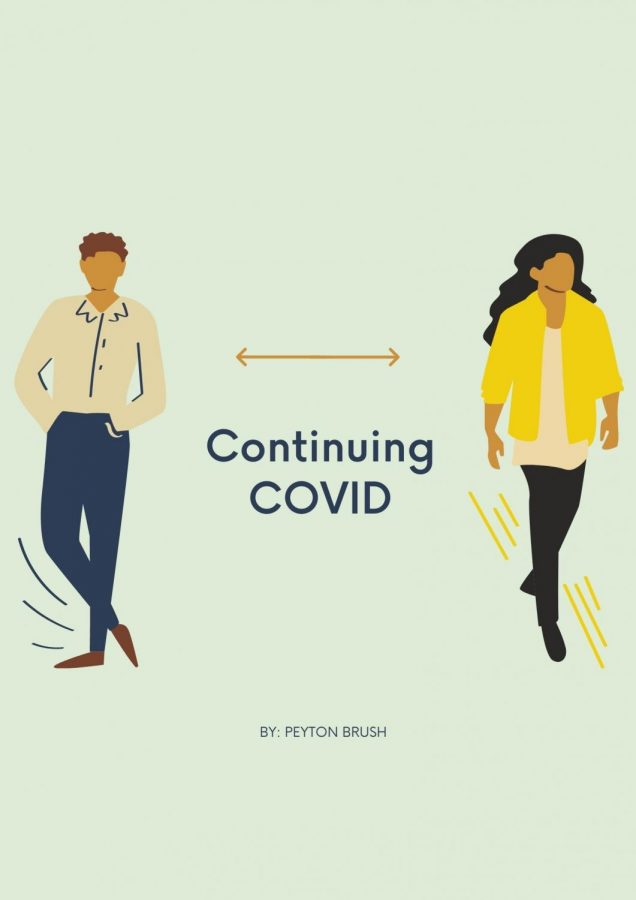Continuing COVID
Pandemic brings about changes to CISD
September 20, 2020
As the COVID-19 pandemic continues to sweep the nation, everyone in the United States is trying to adapt. Although the summer did have its countless issues regarding the pandemic, come August, the concept of opening schools again in the midst of the chaos was a heavily controversial and debated topic. Carroll ISD, a month before school began, eventually made their decision for how to teach the upcoming school year.
The school board decided in late July that it would host both in school and online classes and allow parents to choose. Online students will follow their same schedule as if they were in school while attending Zoom classes in a program called Dragon Virtual Academy.
Many took advantage of this opportunity, with about 1,600 parents signing up their children for remote learning. More than 2,600 parents signed up their children for in person teaching.
In-person learning has seen numerous changes from last year. The students are expected to wear masks at all times, they can only enter through certain doors, and they must always present their school ID when entering the school. When students are in the school they cannot congregate with one another in the hallways and cafeteria. Students cannot use the restroom during passing period to limit the number of people there at the same time.
When in the classroom, masks will stay on, and students are to remain at their desks and limit interaction with one another. After class ends, they must disinfect their desks to ensure a clean environment for the next class.
This integration of teaching styles has presented some impediments as expected, as teachers and students alike learned how to deal with these new, strange times.
“Honestly, I think the events of this year have forced teachers to rethink how they deliver instruction and learn how to be a quality teacher in different venues, ” English teacher Mrs. Burkamp said. “If you’re a good teacher in the classroom, it’s likely because you’re a flexible person with good problem-solving capabilities, which should translate to how you deliver online instruction if you maintain the same mindset. I would also say that I do even more self-evaluation of how lessons are working and not working.”
Dragon Virtual Academy has some challenges. Some online students are unhappy with a presumed lack of fully understanding all the intricacies of what they are trying to learn.
“I do feel that I am unable to get the full scope of what an in person education would offer—perhaps a consequence of the amount of science and lab based classes I scheduled—as well as an immense sense of awkwardness when speaking to ask or answer a question through Zoom,” said senior Stephen Chuang.
The in person students also are facing difficulties with their school life, highlighted by senior Grayson Walthall.
“It’s definitely made things a lot more inconvenient, for school it was hard to keep up with all of the online homework and tests, and for football practice got a lot harder because we had to workout with the masks on,” said Walthall. “It was also pretty annoying to always find a new clean mask that wasn’t drenched in sweat.”
At the same time, most students are understanding of the situation that most teachers are put in. Suddenly having to learn a whole new style of teaching is clearly not an easy task, and the students are well aware of that.
“I think the teachers are doing a great job transitioning in such a surreal situation,” online student, senior Amay Ghia said. “From the viewpoint of an online student, classes are easy to keep up with and synced well with the in person students, it doesn’t feel like we are in a disadvantaged position in comparison to the in person students. Also it is much simpler to keep up with all the class work online in one place for all the classes not having to rely on paperwork in my opinion. Overall, I have been delighted with the transition to online and am glad online is a quite viable option.”
Chuang agrees.
“Both teachers and students have to adapt to the new normal of virtual academies. My teachers have been extremely helpful and understanding in addressing and working around the unforeseen obstacles virtual learning has brought,” he said.
Teachers are also adapting and believe they are gradually improving in their teaching styles and getting a better grasp on teaching.
“The AP Government curriculum hasn’t changed, but I have found that I need to make myself more available to my students, especially my DVA students,” government teacher Mrs. Elizabeth Irish said. “I have more tutorials and meetings with students outside of our regular class time in order to ensure everyone is getting the help and assistance they need.”
Mrs. Burkamp feels the same way about her new teaching style.
“The most important adaptation has honestly been my mindset. Teaching virtually and in-person at the same time isn’t ideal, but it can be done well if the teacher actively seeks ways to build relationships with his or her virtual learners and ways in which they can connect with their in-person classmates,” Burkamp said.
This year seemingly having many issues, most everyone still manages to maintain a sense of confidence and know that eventually they will be able to optimize the two teaching styles.
“I am extremely optimistic about the future,” Irish said. “ I look forward to the day that we can all be back at school learning face-to-face, but in the meantime, we’ll make the best out of our current situation. The teachers and students at CSHS are definitely up to the task.”


